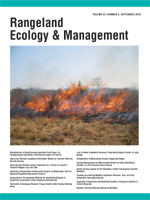Medusahead (Taeniatherum caput-medusae [L.] Nevski) is an exotic annual grass invading western rangelands. Invasion by medusahead is problematic because it decreases livestock forage production, degrades wildlife habitat, reduces biodiversity, and increases fire frequency. Revegetation of medusahead-invaded sagebrush steppe is needed to increase ecosystem and economic productivity. Most efforts to revegetate medusahead-infested plant communities are unsuccessful because perennial bunchgrasses rarely establish after medusahead control. The effects of prescribed burning (spring or fall), fall imazapic application, and their combinations were evaluated for medusahead control and the establishment of seeded large perennial bunchgrasses. One growing season after treatments were applied, desert wheatgrass (Agropyron desertorum [Fisch. ex Link] Schult.) and squirreltail (Elymus elymoides [Raf.] Swezey) were drill seeded into treatment plots, except for the control treatment. Vegetation characteristics were measured for 2 yr postseeding (second and third year post-treatment). Medusahead was best controlled when prescribed burned and then treated with imazapic (P < 0.05). These treatments also had greater large perennial bunchgrass cover and density compared to other treatments (P < 0.05). The prescribed burned followed by imazapic application had greater than 10- and 8-fold more perennial bunchgrass cover and density than the control treatment, respectively. Prescribed burning, regardless of season, was not effective at controlling medusahead or promoting establishment of perennial bunchgrasses. The results of this study question the long-term effectiveness of using imazapic in revegetation efforts of medusahead-infested sagebrush steppe without first prescribed burning the infestation. Effective control of medusahead appears to be needed for establishment of seeded perennial bunchgrasses. The results of this study demonstrate that seeding desert wheatgrass and squirreltail can successfully revegetate rangeland infested with medusahead when medusahead has been controlled with prescribed fire followed by fall application of imazapic.
How to translate text using browser tools
Kirk W. Davies
ACCESS THE FULL ARTICLE
annual grass invasion
fire-herbicide control
invasive plants
prescribed burning
sagebrush community restoration
Taeniatherum caput-medusae





